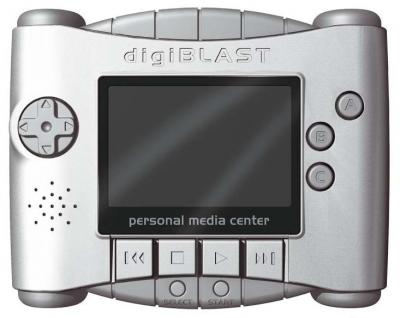|
The digiBLAST is a European handheld released in 2005. The short-lived console was initially developed by the Grey Innovation a commercialisation technology company based in Melbourne, Australia.
The console was less powerful than the market leader at the time, the GameBoy Advance, but aimed at a younger audience. The console was intended to children between ages 4 to 9. Grey Innovation had planned to release the console in Europe in September 2005 and North America at a later date.
For the European release, Grey Innovation partnered with Nikko, a Dutch company that primarily manufactures radio-control toy for distribution. The digiBLAST finally launched in November 2005 simultaneously in Netherlands, France, Italy, Turkey, Spain and Luxembourg, just in time for the holiday. Grey Innovation and Nikko were really enthusiasts and planned to sell 200,000 units during the Christmas season.
The Linux-based handheld was relatively cheap compared to its peer and had everything on paper to be successful toward a younger audience. The console had an interesting line-up at launch such as Atari Classics, Rayman 3: Hoodlum Havoc, Spider-Man: Mysterio’s Menace, Tony Hawk’s Pro Skater 4 and X2: Wolverine’s Revenge. The console that was marketed as a portable media player also had the ability to play episodes from various kid show such as Sonic X, SpongeBob SquarePants, Teenage Mutant Ninja Tutrles, etc. The episodes came on a game cartridge. Each cartridge cost 9,95€ and contained 3 episodes for a total playtime of 75 minutes. The game cartridges were priced at 14,95€ which was really affordable at the time.
The console could also be connected to a television through an additional peripheral. Another accessory called the MP3 Player could also be purchased at the price of 29.95€. The MP3 Player was a special cartridge that would allow to transfer up to 256 Mb of music from a computer. The company had also planned to release a digital camera attachment, but never had the chance to go forward with the idea.
Upon release, the critics didn’t share the enthusiasm of the creator of the console. Some complain about the build quality that was not on par with the expectation. The 2.7-inch LCD screen was prompt to ghosting and the speaker was subpar. Other on the relevance of the console itself as it was designed to compete with the GameBoy Advance, but was released a few months after the Nintendo DS.
Although a heavy marketing campaign, praising the multimedia capacity of the device, the digiBLAST was not able to create any buzz around its release. The final nail on the coffin was a shortage of chip around the time of the release making the console and the games hard to obtain.
Following the failed Christmas launch, digiBLAST stayed in selected stores and was relaunched for Christmas 2006, but failed again to generate any interest.
The console sold only 100,000 units over its lifespan.

